Day 3, the final day, of a long weekend of tours today. After spending much of the last few days enjoying the waifs and strays from Siberia that had been blown onto our coastline, it was time to catch up with some waders and wildfowl. We set off west along the coast to Titchwell for the morning.
Before it got too busy, we had a look around the overflow car park. The bushes here are laden with berries at this time of year and the apple trees full of apples – good feeding for the birds. Lots of thrushes burst from the vegetation as we walked through – a large flock of ‘teeez-ing’ Redwings, several ‘tic-ing’ Song Thrushes and a good number of ‘chuck-ing’ Blackbirds too. A single Mistle Thrush perched up in the top of a tree across the field at the back.
There were lots of finches as well – Greenfinches and Chaffinches in the bushes, Goldfinches feeding on the ground around the edge, and we flushed two Bramblings from the hedge as we passed which flew off calling loudly. We could hear Long-tailed Tits calling from the trees and several more Goldcrests. They seem to have been ever-present this weekend, exhausted birds fresh from the continent, feeding up along the coast before dispersing inland, though there were perhaps slightly fewer here already than in recent days.
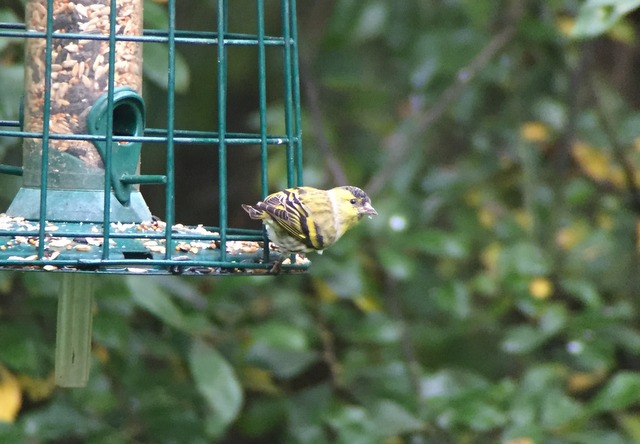 Siskin – a single male was on the feeders by the visitor centre
Siskin – a single male was on the feeders by the visitor centre
We stopped to look at the feeders by the visitor centre. Amongst more of the regular finches, one smaller bird stood out. A single male Siskin, green and yellow with a black cap, was picking at the seeds on the end feeder. There were a couple of Coal Tits too, darting in, grabbing a seed and flying straight out to the safety of the bushes.
Looking across the grazing meadow, a female Marsh Harrier hung over the edge of the reeds before dropping down to perch in the top of bush, where we could get a good look at it through the scope. When it flew again, we could see the pale patches on the leading edge of the inner wings. A Chinese Water Deer was feeding quietly on the far edge of the field.
The grazing meadow pool is still drained, but had a good variety of birds around the muddy puddles today. A single Greenshank was feeding on one of the larger pools with a couple of Redshank and a Dunlin. A Ruff nearby provided a good opportunity to compare with the Redshank – the shorter, slightly downcurved bill, paler head and the neatly scalloped grey-brown back distinguishing it. A lone Ringed Plover was out on the open mud further back. A couple of Snipe were feeding well-hidden in the grass on the drier side.
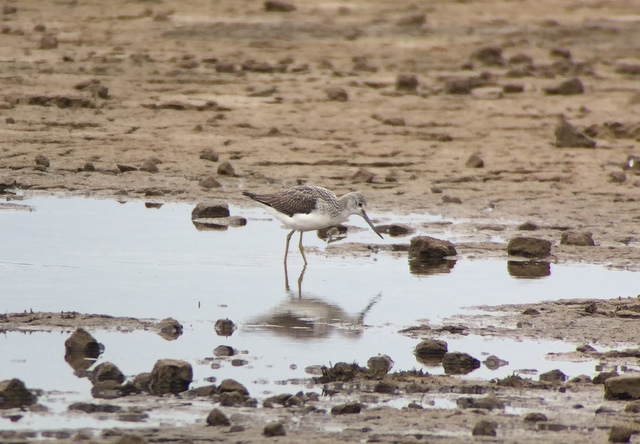 Greenshank – on one of the puddles on the grazing meadow pool
Greenshank – on one of the puddles on the grazing meadow pool
There were several Reed Buntings, appropriately enough in and out of the reeds along the edge but a couple landed out on the mud where we could get a better look at them. A couple of rather grey-backed Robins were also chasing each other around the reeds – presumably migrants from the continent which had stopped here to feed up. Out in the middle, plenty of Pied Wagtails and Meadow Pipits. A much darker bird flew in and dropped down on the edge of the channel, a Rock Pipit. The reedbed pool was very quiet today, just a couple of Coot and two Little Grebes.
Out on the freshmarsh, a large flock of Golden Plover was busy bathing and preening around the edge of the nearest islands. We could hear their mournful calls as we walked out to Island Hide. We got them in the scope and admired their golden-spangled upperparts.
 Golden Plover – a large, noisy flock was on the freshmarsh
Golden Plover – a large, noisy flock was on the freshmarsh
There was a good selection of other waders out on the freshmarsh too today. Another long line of sleeping waders was further out in the shallow water, Bar-tailed Godwits roosting over high tide out on the beach. With several Black-tailed Godwits feeding behind them, we could get the two species in the scope together and look at the differences in size and upperpart colour and pattern. Nearby, a tighter flock of smaller grey waders similarly asleep were Knot, also sitting out the high tide. There were only two Avocet today, a big decrease on the record numbers here at the end of the summer. Several diminutive Dunlin were scuttling around the edges of the islands and two equally small Ringed Plover were on the mud. Just a single Turnstone was lurking amongst the ducks on the rocks on the furthest island.
The number of ducks continues to increase, with mainly Teal and Gadwall out on the freshmarsh at first. The drakes of the latter species are now pretty much back in full breeding plumage, but the Teal are still emerging from eclipse, with a variable mixture of new feathers and older patterned brown ones. There were not so many Wigeon initially, until suddenly a large flock of Brent Geese flew up from the satmarshes over towards Brancaster and came in to wash and preen. They brought a lot of Wigeon in with them. Something had presumably flushed them from where they had been feeding.
 Teal -a drake still emerging from eclipse plumage
Teal -a drake still emerging from eclipse plumage
There were also a few Shoveler out from Island Hide, but they were mostly asleep. On the rocky point of the furthest island, we found a single drake Pintail. It kept going back and forth from the vegetation to the water’s edge, seemingly with food.
As we walked on round to Parrinder Hide, a Marsh Harrier drifted over the back of the freshmarsh from the reedbed and flushed everything. All the ducks and waders scattered, and the flock of Golden Plover took to the air and swirled round overhead.
 Golden Plover – took to the air as a Marsh Harrier drifted over
Golden Plover – took to the air as a Marsh Harrier drifted over
From round at Parrinder Hide, there were not so many birds left on the freshmarsh after the best efforts of the Marsh Harrier. There were several Shoveler and Teal feeding below the hide – the drake Shoveler, like the Teal, still emerging from eclipse plumage. Another Rock Pipit dropped onto one of the islands out in front amongst the Meadow Pipits, giving us a nice side by side comparison.
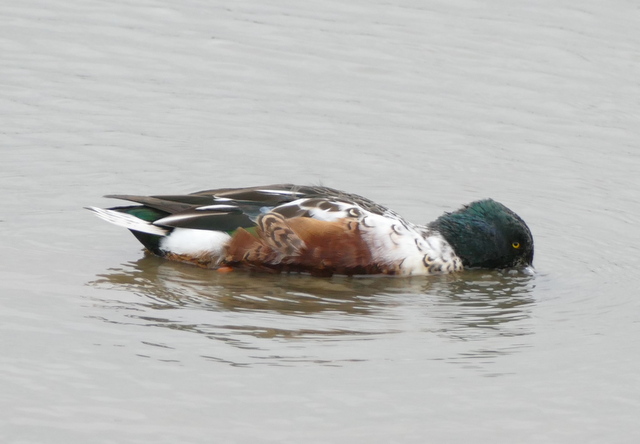 Shoveler – the drakes are also just emerging from eclipse plumage
Shoveler – the drakes are also just emerging from eclipse plumage
The high tide was starting to recede off the Volunteer Marsh. There was a scattering of Curlews, Redshanks, Grey Plovers, Black-tailed Godwits and a few more Dunlin out on the emerging mud.
 Redshank – out on the Volunteer Marsh
Redshank – out on the Volunteer Marsh
Back on the main path, the Little Egret was in its usual place, where the water flows into the main channel, over a bank of mud on the north side of the Volunteer Marsh. Presumably it knows it can find fish and invertebrates that are carried out by the receding tide more easily in the shallows here.
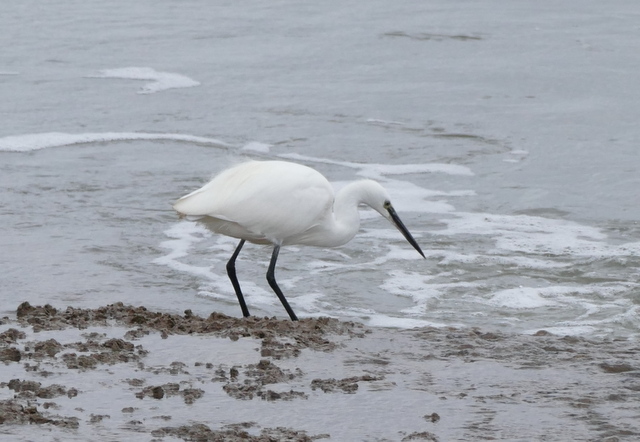 Little Egret – feeding in its usual place on the Volunteer Marsh
Little Egret – feeding in its usual place on the Volunteer Marsh
The Tidal Pools were quieter than they have been in recent weeks. Just a few Redshank and Black-tailed Godwits, and only 1 or 2 Grey Plover were feeding out around the islands. There were not the numbers of waders roosting on here today, despite high tide. We did at least get great close-up views of Black-tailed Godwit, as usual.
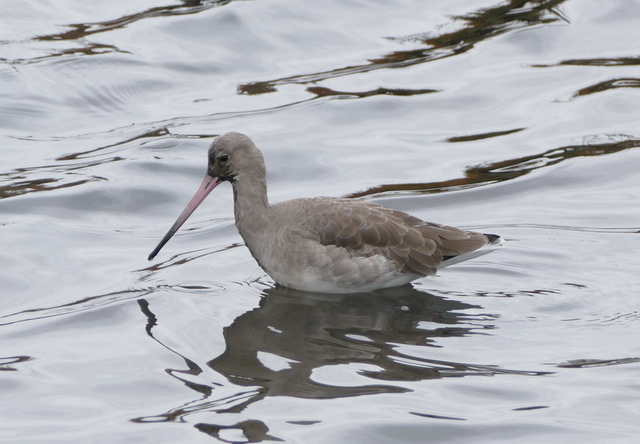 Black-tailed Godwit – great to be able to see them so close here
Black-tailed Godwit – great to be able to see them so close here
Out on the beach, the tide was still covering the rocks but there were nonetheless lots of gulls and waders feeding on the sand, presumably on detritus washed up on recent northerlies. Amongst them, a couple of Sanderlings were running around like clockwork toys. Looking out to sea, we could see lots of Common Scoter flying round very distantly offshore. There were several Great Crested Grebes on the water, one close in where it was easier to see. Small numbers of Gannets were flying past, but one larger group came west in formation round Scolt Head as a bank of low, dark cloud swept in over the sea. It looked like rain coming in, and it started to drizzle, so we beat a hasty retreat.
On our way back, we diverted round via Meadow Trail. We had heard plenty during the morning, but a Cetti’s Warbler sang right next to us as we walked along the boardwalk. We couldn’t see it at first, but then it flew across the path right in front of us – a flash of a rusty-brown back – and landed low down in the sallows on the other side. We watched it as it moved slowly back through the branches.
Just around the corner, a Kingfisher flashed across the small pool by the boardwalk calling and disappeared over trees in a flash of electric blue. It was all a bit quick. Then as we were walking past Fen Hide, we heard another Kingfisher call. We popped in quickly just in time to see it sat up in the reeds briefly before it shot off over the reeds.
We had enough time for a quick look at Patsy’s Reedbed. Amongst the hordes of sleeping ducks, mainly Mallard, Teal and Gadwall, we counted a total of 14 Red-crested Pochard (the most we have seen here recently) and a single Common Pochard. Several Snipe were around the edge feeding on the mud. Then it was time to head back for lunch. As we walked back, a Marsh Tit called from the hedge and we saw it making its way quickly along towards the trees.
After lunch, we had a quick look out beyond the back of the car park for a couple of Ring Ouzels which had been reported earlier, but there was no sign of them. We did see lots of thrushes and Blackbirds zipping around in the trees beyond the paddocks. We decided to move on.
 Barn Owl – one of at least 3 hunting over the grazing marshes
Barn Owl – one of at least 3 hunting over the grazing marshes
We drove west to Holme next. We parked by the seawall and climbed up to scan the marshes either side. Just about the first bird we saw was a Barn Owl out on the grazing marsh. It landed on a post on the fenceline opposite and stood there scanning the grass below. We watched as it flew along from post to post, working its way along the fence. Suddenly one of the group called out and we turned to see a Short-eared Owl circling over the back of the grazing meadows, pursued by a couple of Jackdaws. We noted the distinctive stiff wingbeats, like a rowing action, before we eventually lost it behind the trees. There were also five Pink-footed Geese feeding out on the grass below us.
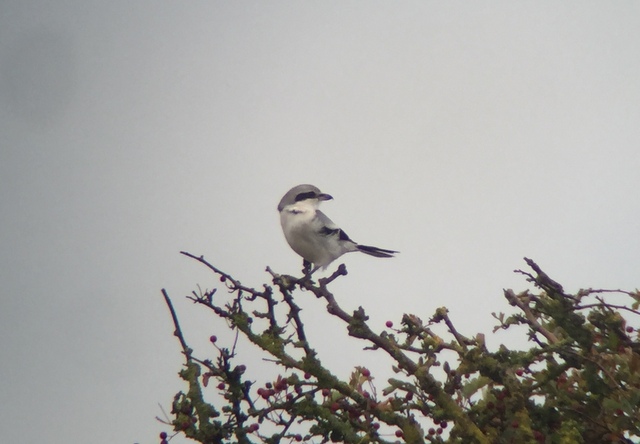 Great Grey Shrike – first one flew in to the hawthorns by the entrance track
Great Grey Shrike – first one flew in to the hawthorns by the entrance track
We couldn’t see any sign of a Great Grey Shrike at first, but suddenly one appeared from nowhere. We turned to see it fly in and land on the very top of hawthorn. It perched there for a while looking round. A Meadow Pipit came to mob it but appeared to have second thoughts and flew off again. Then the shrike flew further back along the road, and landed again in the top of another bush. We started to walk further along towards where it had gone when it flew again and disappeared behind the bushes ahead of us. We continued further along to the paddocks, which seemed the mostly likely place it might have gone, scanning both sides of the seawall, but we couldn’t find it again.
As we turned to walk back, we could see dark grey clouds gathering behind us. We almost made it back to the car before it started to rain. It was just a shower, so we took shelter until it quickly cleared. Afterwards, we climbed back up onto the seawall and started to scan the marshes again. It didn’t take long after the weather cleared for a Great Grey Shrike to appear again. It was ‘a’ rather than ‘the’ Great Grey Shrike because when we got it in the scope it appeared to be a second bird. There have been two shrikes here recently and this one appeared to be an adult, rather than the 1st winter bird we had seen earlier. It perched up in the top of a hawthorn for a while, out across the grazing marsh, before it flew straight towards us. It landed on the top of a dead dock, swaying in the wind, for a while. Then it flew back across the grazing marshes and disappeared from view. Two Great Grey Shrikes – not bad! There were also two Stonechats perched up in the top of the hawthorns by the entrance road.
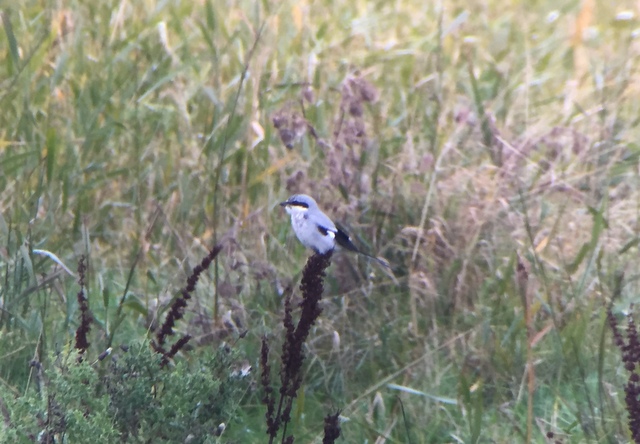 Great Grey Shrike – a second bird out on the grazing marshes
Great Grey Shrike – a second bird out on the grazing marshes
Having managed such great views of the two Great Grey Shrikes so quickly, we walked out to have a look at the sea at the mouth of the Wash. There were lots of Brent Geese and waders on the beach – mostly Knot, Bar-tailed Godwit and Oystercatcher. Out on the sea, rather distantly, we could see hundreds and hundreds, if not thousands of Common Scoter, presumably feeding on shellfish offshore. There were also a couple of Red-throated Divers, but they were hard to see as they were quite a long way out.
Scanning over the sea, we picked out a very dark blackish brown bird, a bit like a large gull, flying past – a Great Skua or Bonxie. We could see big white wing flashes in the tips of its wings as it flew. It dropped down onto the sea and sat bobbing around between the waves. We could see a couple of fishing boats out in the mouth of the Wash, and they appeared to be bottom trawling, possibly for shrimp. These boats can cause a mass of destruction, as they dredge up everything from the seabed, wanted and unwanted. A huge cloud of gulls was following behind, presumably cashing in on all the bounty stirred up from the bottom. At the back, a second Bonxie was harrying the gulls. But it will be interesting to see if the Common Scoter remain offshore once the trawlers have finished.
It was getting late and the light was fading, so we walked back towards the car. We scanned the marshes as we went but there was no further sign of either Great Grey Shrike or the Short-eared Owl, we had been lucky to see them when we did. Unfortunately it was time to head for home.
















